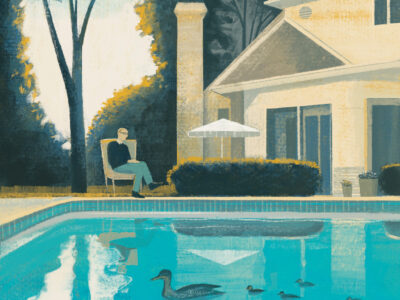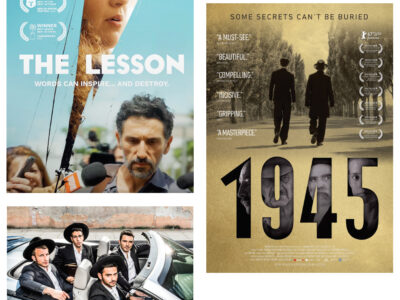
Photography by Ethan Pines
Class of ’98 | Ever since his first screenplay, 500 Days of Summer, became a hit movie starring Joseph Gordon-Levitt and Zooey Deschanel in 2009, Scott Neustadter C’98 has been weaving stories and scripting lines for some of the film industry’s bigger projects and best-known actors.
Recently (after adapting three popular young-adult novels for the screen) Neustadter and his longtime writing partner Michael H. Weber worked with James Franco and Seth Rogen on The Disaster Artist, which cracks open the bizarre 2003 indie film The Room—and defies a quick plot summary. It’s based on a book by Greg Sestero about his friendship with Tommy Wiseau (the filmmaker behind The Room). Directed by Franco, who also plays the role of Wiseau, it stars his brother, Dave Franco, as well as Rogen, Zac Efron, Sharon Stone, and Bryan Cranston (as himself).
For all his screenwriting success, Neustadter remembers having “zero confidence” in his writing ability as a Penn student. He took as many film-studies classes as he could and tried out playwriting and screenwriting courses, but he figured he’d help develop movies someday, not write them.
“In college I was more of an introvert—withdrawn, reticent,” he says. “I didn’t drink, never really partied. Also, I looked like I was 11 the whole four years, which didn’t help.”
After graduation he went to work as a story editor at Tribeca Productions, the company founded by Robert De Niro and Jane Rosenthal, where he met Weber, an intern at the time. He gradually realized that reading scripts was less fulfilling at 25 than it had been at 21.
“It was Weber’s idea to sit down on the roof and try to bang one out ourselves,” he says. “And though I still lacked confidence in my writing talent, I had by this point read enough terrible scripts that went on to be hit movies that I figured Why the hell not? And so we did.”
With The Disaster Artist due out later this year, Neustadter was on set in Colorado for Our Souls at Night—a drama he and Weber wrote that stars Jane Fonda and Robert Redford—and writing the next X-Men movie, The New Mutants,when we caught up with him this past fall.
Your writing debut (500 Days of Summer) won multiple screenplay awards. You were at the Golden Globes. What was that year like for you?
Most screenwriters break into the industry with a great script that everybody loves but nobody buys, a passion project that opens a ton of doors but never gets made. And for a while, that was 500 for us. People dug it, but no one really knew what to do with it. Everyone passed. But then we got lucky—several times, actually. The right company optioned it, the right people fell in love with it, and not only did it get made but it got made well. It’s the antithesis of the typical screenwriter experience—nobody gets to start with their passion project. And the fact that it was such a personal script was doubly rewarding for sure.
You’ve adapted John Green’s young-adult books The Fault in Our Stars and Paper Towns into movies. Both have huge fan bases. How does that looming fandom affect your writing process, and what’s your approach to adapting books for the screen?
When we started writing Fault, it was already a bestseller but it wasn’t yet a phenomenon. So I don’t think we felt the pressure we might have had we started it a few months later, say, when things got really crazy and people were tattooing quotes on their bodies. Still, our writing process probably wouldn’t have changed very much. On Fault, and later on Paper Towns and Looking for Alaska, our approach was to follow our instincts, write the best draft we knew how to write, and only once it was finished and ready to be read did we share it with John for his feedback, which of course was invaluable.
Is there a different kind of pressure with adaptations than when you’re starting completely from scratch?
The cool thing about adapting something versus writing an original is that you get to be a fan first. You read something, you fall in love with it, your primary goal is to replicate in movie form that feeling you got from reading the book. That’s not something that happens when it’s your own idea because you don’t have those same sign posts. You’re much more in the weeds.
The Room has a big cult-fan base, and it’s been called the worst movie ever made. How did you get involved with The Disaster Artist, and why did you want to tell that story?
I had heard of but never seen The Room when Rogen and his producing partners sent us the memoir The Disaster Artist. It’s a fascinating book, all about the experience of making what is inarguably the nuttiest movie of all time, and we both just flipped for it. Relationships are always at the heart of everything we write, and the relationship between [The Room writer/director/star] Tommy Wiseau and his friend and co-star Greg Sestero was so strange and complicated and unique that we really found it fascinating.
How did you first see The Room? Did you go to one of the midnight showings?
The first time I saw it was while I was reading the memoir—on my laptop by myself, with my wife occasionally looking over and asking “—the fuck is that movie?” But then the whole group of us (Franco, Rogen, et cetera) went to a midnight showing in Westwood with Tommy introducing the screening. Seeing it with an audience who had seen it thousands of times, who knew every line and could point out things I hadn’t even noticed, was both illuminating and hilarious.
Talk about how The Disaster Artist approaches the Room phenomenon.
Our movie is really about How did this thing happen? We’re not passing judgment on the film itself or these people as artists or anything like that. We’re just really fascinated by this friendship, how it came to be, why it blossomed, and then how its ebb and flow led to such a unique and unforgettable piece of cinema. It’s funny for sure, but it’s also—hopefully—poignant. That happy/sad is really the tone I always like to strike in everything we do.
What was it like on the Disaster Artist set?
About half of The Disaster Artist is the filming of The Room, which means a lot of behind-the-scenes, movie-within-a-movie type stuff. Which meant you never knew if the pretzels you just took a handful of were meant to be eaten or were an inedible prop. I made this mistake at least six times. Plus you had James Franco in makeup as Tommy Wiseau, directing a scene as James Franco, but looking, and often sounding, like Tommy Wiseau.
What exactly is the writer’s role on a set?
Writers aren’t always even invited on set. We’ve been fortunate to work with some very collaborative directors who have been totally welcoming and even appreciative of us being around. Franco was the same way. Usually we’re flies on the wall, but on occasion a line won’t work or something is confusing and we can be helpful.
What are you hoping to do in the next couple years, work-wise?
Just trying to keep it going, to be honest. So many things have to break the right way to actually get a movie made. We know how lucky we’ve been and can only hope the next few years are as rewarding creatively as the past few have been. One thing we are doing is trying new things—a teen comedy set in 16th-century Verona or this X-Men movie, for example. It’s always fun to mix it up a little bit and see what happens.
—Molly Petrilla C’06




